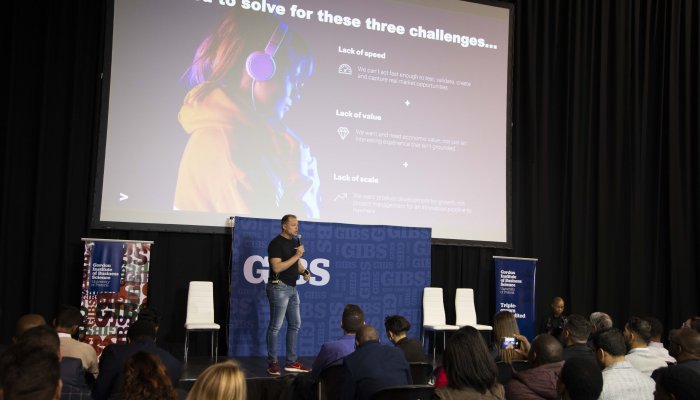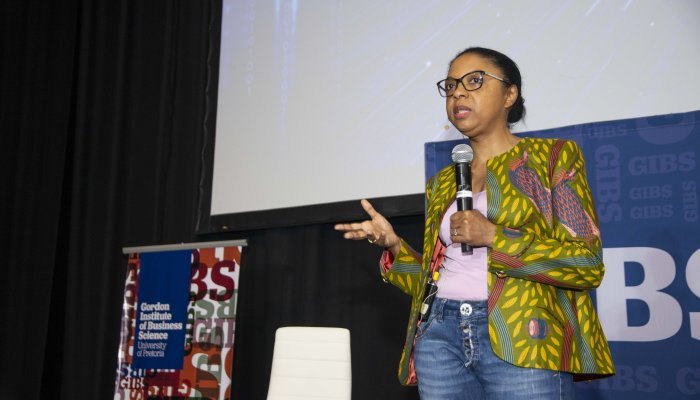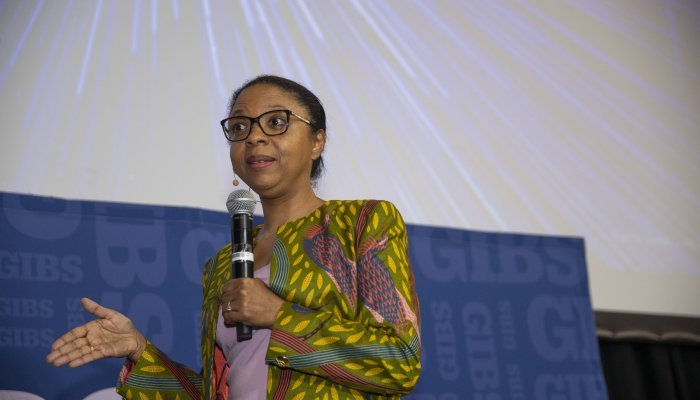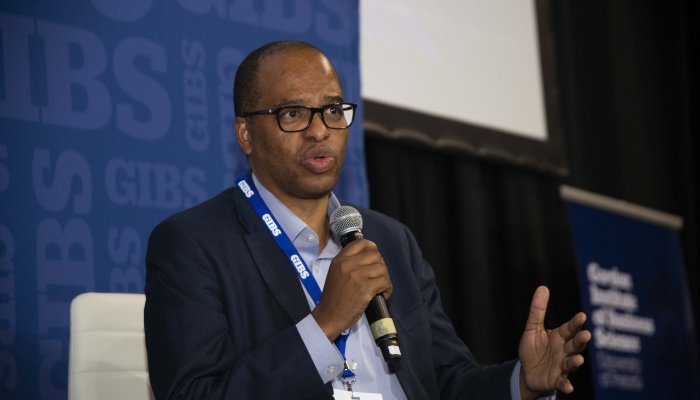Leadership
Capabilities and mindsets
“Digital transformation is here to stay, and it is accelerating a lot of change,” the chief financial offier of Microsoft South Africa, Welela Dawit, told the conference. “If you want to be relevant, you have to adopt it. An attitude of continuous learning is absolutely critical.”
Speaking to GIBS Dean, Professor Morris Mthombeni, Dawit said, “In a digital world, leaders must learn to be comfortable with being uncomfortable. They have to be able to experiment and fail fast.”
Mthombeni pointed out that many organisations rush into digital transformation and are disappointed with the eventual outcome.
“Digital transformation is more than just a mission statement,” Dawit explained. “To drive an effective digital transformation strategy, you must have a clear vision that is cascaded to all levels of the organisation. The strategy must be appreciated and understood at all levels in order to drive culture, and people have to understand how it is going to benefit them and their career trajectory.”
Distributed decision making is important to drive accountability and shared responsibility, which in turn feeds into a coherent strategy.
Leaders in a digital world must develop a growth mindset for themselves and create a culture that encourages the same for their employees. “It is essential that today’s leaders have the ability to unpack complexity and think critically. Drive and encourage unconventional thinking, as this is where learning, development and change happens,” Dawit said.
“Digital transformation is an imperative of our time,” Dr Roze Phillips, the executive director of value creation at GIBS, told the conference. However, “leadership is not ready, enabled or equipped for the change,” she argued.
“The problem is transformation, not digital,” Phillips said. “Leaders are equipped to deal with the past, but they need to change their mindset to lead the future.”
The way in which we think about the future is fundamentally flawed due to a linear progression fallacy that anticipates incremental, stable change, she explained. However, technology changes exponentially, and not in a linear fashion. “Because of this, we tend to miss the early, weak signals of major future trends.”
“Technology is going to provide opportunities for us to do things that we never imagined, including poverty alleviation and slowing down climate change,” Cathy Smith, the managing director of SAP Africa, said.
Speaking to Howard Fox, managing executive of marketing, digital and commercial at GIBS, Smith said tech for good is what excites her most about the future.
She suggested that digital leadership requires those who steer organisations to acquire a certain level of knowledge and invest their time and energy in educating themselves about technology.
“They can no longer outsource to the IT department. You have to keep yourself current and up to date in an attempt to understand the future. Attitude and passion are what matter. You must want to learn every single day.”
However, she advised leaders not to try to compete with the experts. “Your responsibility is to create an environment where they can thrive and perform.”
Anesu Charamba, founder and management consultant at the Ithaca Consulting Group (ICG), explained that modernising technology alone is not a digital transformation strategy. “The business also needs to change its processes, people and culture.”
He advised those embarking on a digital transformation strategy to “have a plan, stick to it, and make sure everybody has a sense of ownership. Don’t add more complexity to the strategic execution than is necessary, and effectively use the tools available to you to outcompete.”
Ways of working – building a future-fit workforce
Remote working and the new normal
Remote work, enabled by digital channels and accelerated by Covid lockdowns, transformed our mindsets and caused many to question the very meaning of work, Phillips said.
“As organisations struggle to attract employees back on site, we are trying to solve for location and productivity, where in fact there is a values mismatch,” she said.
“Remote and hybrid working are here to stay,” Microsoft’s Dawit said. “Mental health and well-being are a priority for employees, and companies have to bridge the physical and digital space through investments in both their offices and technology to allow for flexibility.”
The flexibility of hybrid working has its advantages, as does the connection and energy produced by working together as a team in the office. “The question is how to make the commute worth it for many employees to attract them back on site. Flexibility means the office isn’t the only place where work can get done, but we also have to be aware of digital fatigue.”
Dawit said digital transformation is an enabler to allow individuals and organisation to do more. “We have to use digital tools on top of the foundation we already have to create efficiencies. It is important to upskill our existing talent as they have the institutional memory.”
The executive director of faculty and director of the MBA programme at GIBS, Hayley Pearson, told the conference that the workforce of the future will need to upskill, reskill and engage in continuous learning. "The World Economic Forum (WEF) estimates that by 2025, just three years away, 50% of all employees will need to reskill due to adopting new technologies. One-third of essential skills in 2025 will consist of tech competencies not yet regarded as crucial to today’s job requirements."
The half-life of a skill learnt today, or the time it takes for that skill to be considered obsolete, is four years, while that of tech skills is two and a half years, Pearson explained.
“How relevant and competitive will you and your organisation be in five years’ time?” she asked.
The WEF’s list of skills needed for employment in 2030 includes, among others: Analytical thinking and innovation; active learning; creativity, originality; influence; reasoning and complex problem solving.
“Creativity and dexterity cannot be replaced by artificial intelligence (AI),” Pearson said.
Neither can curiosity: “Leaders must build a workforce that is deeply curious and continuously learning. There is an excessive amount of content available for continuous learning, including online courses, massive open online courses (MOOCs), video courses, bootcamps, podcasts, audio books, ebooks and open courseware. But people must want to learn.”
The tech
Which technology and why?
Digital technology is often the most daunting aspect of organisational digital transformation. AI, automation, the cloud, big data, the internet of things – the list of new technologies available to make business more competitive seems endless.
Professor Johan Steyn, who is an author and AI and automation thought leader, advised delegates to use the right technology, for the right reason, to enhance their competitiveness.
Steyn’s comments on automation could be applied to the general principle of digitisation: “The end goal of automation (or digitisation) is efficiency and effectiveness gains. Embark on projects to automate the right things, for the right reasons and in the right way.”
Often, when navigating the challenges of digital transformation and assessing your organisation’s digital readiness, “the tech is the easy part of digital transformation. The difficult part is deciding what the problem is you are trying to solve,” Riaan Singh, partner of strategy and digital transformation at PwC South Africa said.
Digital transformation is not a destination, but rather a journey, he added. “Digital transformation is an ongoing initiative, not a project. The aim is to build long-living teams and structures.”
Many organisations are looking to digital in order to unleash corporate innovation, agility, and efficiencies, Rory Moore, the tech innovation lead for emerging markets at Accenture, said. “Innovation and collaboration are a team sport: First there was collective genius, and now we have moved onto augmented genius, which is collaboration with computers, humans and machines.”
However, this should not be cause for concern: “Machines of the future will do the dull, dirty and dangerous jobs. The future is changing. Either you change with it, or you get left behind.”
SIDEBARS
Use cases
Automation: Prof Johan Steyn, author and AI and automation thought leader
“Automation is here, and it is powerful.”
“You shouldn’t fear that a robot takes your job; you should hope they take the repetitive stuff and remove the admin burden.”
“Experience cannot be automated; decisions made by intuition cannot be automated.”
Big data and the internet of things (IoT): Professor Manoj Chiba, GIBS
“Digital transformation is not about one or two trends, but rather a combination. Artificial intelligence cannot work without data.”
“IoT is a source of data that can connect in real time. Big data is pulling together different data. It takes multiple intakes to create understanding. The value of data is when you are able to pull it all together.”
Artificial Intelligence (AI): Dr Jeff Yu-Jen Chen, GIBS
“Companies must ask how they can use AI to better serve their customers and outcompete. The idea is to take the robot out of the human, as this will reduce menial and routine tasks.”
“The goal of AI is to give your organisation an artificial intelligence dividend, which is a competitive advantage. AI is not the goal in itself.”
“The power of AI comes from the combination and facets combined. Without data, there is no AI.”
“Digital transformation is in actual fact cultural transformation. Be sure to develop your future consciousness and future orientation in order to create the understanding that there are multiple possible futures.” – Dr Roze Phillips, executive director of value creation at GIBS
“Technology is going to provide opportunities for us to do things that we never imagined. Tech for good is what excites me most about the future.” – Managing director of SAP Africa Cathy Smith













